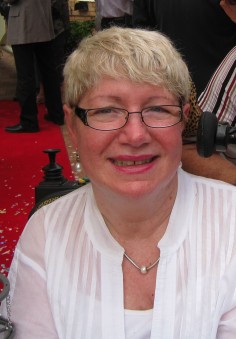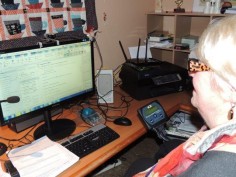Living the life you choose with assistive technology
22 August 2014

A blog by Athena Doropolous highlights how living in an accessible home with access to natural supports, telecare and a diverse range of assistive technologies enables her to live the life she chooses to. Maybe some of this technology would work for you or someone you know?
My name is Athena. I’m in my late 50s and have MS. I am very active in the community, catching up with friends regularly, going to the theatre and other performances and enjoying the outdoors. When I’m feeling really adventurous, I even attempt abseiling! I have been living in my purpose-built accessible home in Mount Pleasant for about 13 years, currently with one of my two adult sons. My mother and sister live in the two houses next door and I have a range of supports providing in-home assistance daily.
It’s important I remain connected and I do this using technology. With advice and assistance from the Independent Living Centre (now rebranded to Indigo), I’ve been able to continue using my computer independently. I use a camera mouse where I control the cursor on the computer screen by moving my head (once I have the sensor placed on my forehead). If I turn my head left, the cursor drags to the left side of the screen. When I hold the cursor over a tab or link, it serves as a click. For writing emails and searching the internet, I have installed speech recognition software that allows me to sound out what I want to write, and it translates on the computer. I have an iPhone, although my primary mode of phone communication is via voice-activated Skype on my computer. With this technology, I am able to have more control with planning my day-to-day activities and upcoming events, researching online and keeping in touch with friends and family.
You May Also Like: Tips for Traveling with Disabilities: Holiday Planning
When I want to watch TV, I have a voice-activated remote control, which allows me to change stations and watch a DVD—although it isn’t developed enough to control the internal DVD menu.
In my bedroom, I have an electronically operated, adjustable bed with an inflatable mattress to manage pressure. I have a back-up power source that lasts about 24 hours because my bed once deflated during a power outage. A hoist is used to help me get in and out of bed. During the night, I use a hydration pack/water bag attached to my bed. The tube is threaded through my T-shirt and adjusted to be near my mouth so I can have a drink at night.  I have an alarm attached to my chest and, if necessary, I can sound it by tapping my chin down. The alarm is connected to an emergency call system, which goes through to a WA-based service. This was important because I wanted to feel I was receiving local assistance. The call centre can talk to me through the base station and summon the right type of assistance. If I can’t talk, they will call emergency services.
I have an alarm attached to my chest and, if necessary, I can sound it by tapping my chin down. The alarm is connected to an emergency call system, which goes through to a WA-based service. This was important because I wanted to feel I was receiving local assistance. The call centre can talk to me through the base station and summon the right type of assistance. If I can’t talk, they will call emergency services.
I use a powered wheelchair with head controls and have been using a side-access modified vehicle for long-distance travel for the past two years.
I get the latest information on assistive technology from my support staff and by researching online. It’s important to remain up-to-date because I want to make the most of my time and maximise opportunities presented to me.

 Translate
Translate